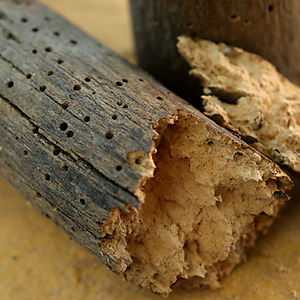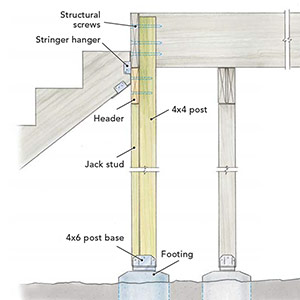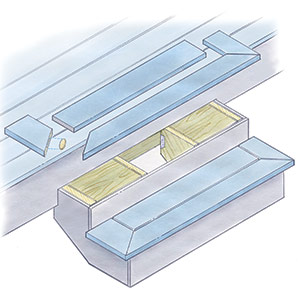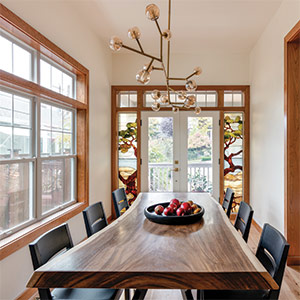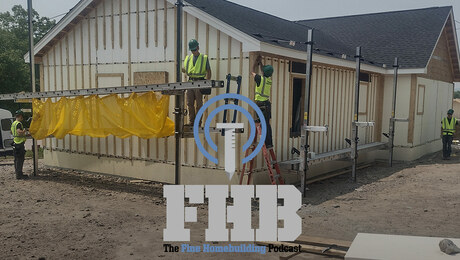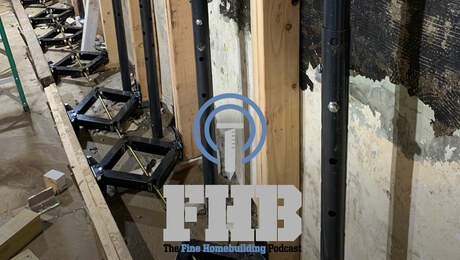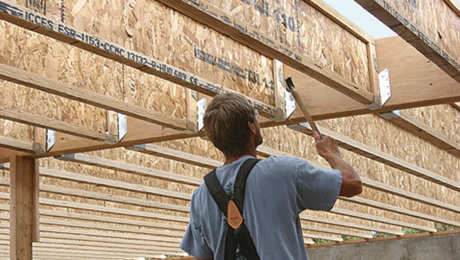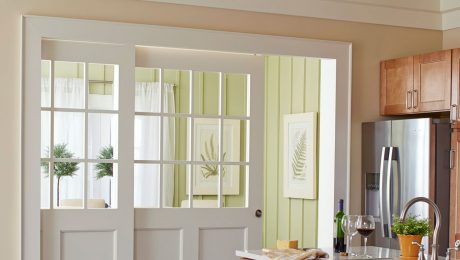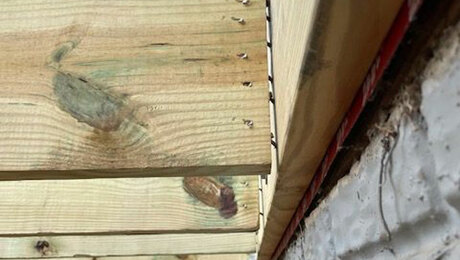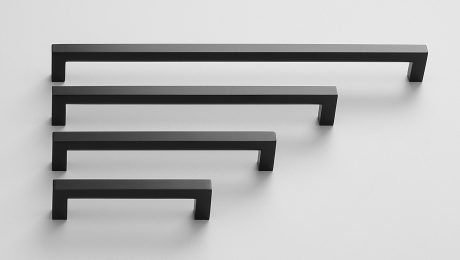The New Pressure-Treated Wood
The EPA is banning CCA lumber. The replacements are safer, but they may change how you build a deck.
Nearly 40 million lb. of arsenic is used in this country every year, and most of it goes into the pressure-treated wood that we use to build decks and playgrounds. But that all changes Jan. 1, 2004. The Environmental Protection Agency (EPA) is banning chromated copper arsenate (CCA) as a preservative for wood intended for residential use (except for the lumber that is used in permanent wood foundations). CCA-treated lumber will still be available for industrial and agricultural use, however.
By the way, there’s no need to panic about existing CCA-treated structures. The EPA says that they’re fine. But if you’re nervous about the chances of leaching chromium and arsenic, you can make your deck or swing set safer by coating it with an oil-based penetrating stain every couple of years.
Taking CCA’s place as a preservative are two waterborne compounds: alkaline copper quat (ACQ types B and D) and copper azole (CBA-A, CA-B). Sold under the trade names Preserve, NatureWood, and Natural Select, they have been used around the world for up to 15 years. These EPA-approved low-toxicity pesticides resist bugs, mold, and rot as effectively as CCA. (See How much safer? for more on quat and azoles.)
How much safer?
Because the azoles and quat compounds in the new preservatives are organic, it’s implied that they are safer than the inorganic chromium and arsenate used in CCA. But organic has a different meaning in the lab than in the supermarket. Gasoline, for instance, is organic. Being organic means only that the new preservatives are made from carbon and hydrogen. These preservatives are not safer because they’re organic; they’re safer because they’re less toxic.
They’re safer for the environment, too. There’s no hazardous waste produced in the manufacture of azoles and quat compounds, and lumber treated with these chemicals can be thrown away at the dump. But you still can’t burn the stuff because burning copper-based preservatives produces toxic smoke and toxic ashes. And you still need to wear gloves and a dust mask when working with pressure-treated wood.
More copper makes the wood more expensive
To make the new preservatives effective, their copper content has been boosted substantially — from around 18% to 96% in some cases. Because ACQ and copper azole contain so much more copper, you can expect to pay from 15% to 35% more than you paid for CCA lumber. The cost varies because the amount of chemical treatment varies. CCA wasn’t that expensive, so most CCA lumber was given a maximum dose of preservatives and rated for ground contact.
To keep down the cost of the new pressure-treated wood, manufacturers will produce different levels of protection (chemical-retention levels) for different end uses (see More choices than before). End-use categories will be marked on the tags stapled to the end of the board, but in general, they’ll be determined by the dimension of the lumber itself. The lowest chemical-retention level will be for 5/4 stock, or decking. One level higher will be 2x lumber, or above ground. Ground contact will be 4x and 6x lumber, and other stock will be treated for permanent wood foundations (PWF, or structural members).
Although most of the time this system of categorizing chemical-retention levels will jibe with the actual end use, a reasonable potential exists for accidental misuse. You need to make sure you’re using ground-contact lumber if that’s what you need.
More choices than before
More copper makes the new pressure-treated wood more expensive. To reduce costs, companies are offering lower levels of treatment (retention levels) than before. Through scientific testing, the American Wood Preservers Association (AWPA) sets standards for retention levels based on end-use applications. The building code approves the standards, and a third-party inspector verifies compliance by wood treaters. You’ll find this information on a tag stapled to the lumber.
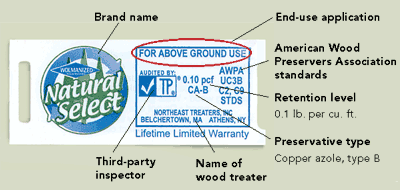
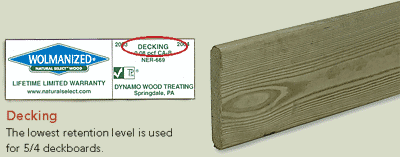
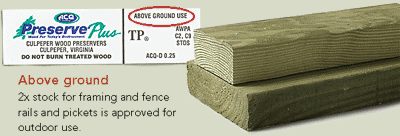
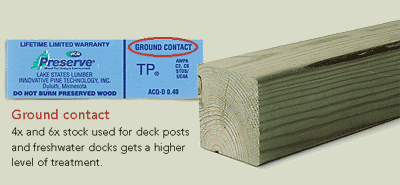
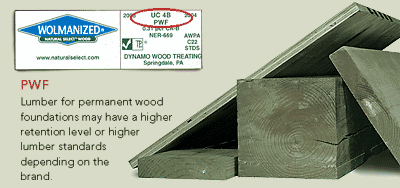
Use corrosion-resistant nails and joist hangers
Unfortunately, boosting the copper content in lumber not only makes the new pressure-treated wood more expensive than the old, but it also makes the new stuff significantly more corrosive — 5 times more to common steel, according to American Wood Preservers Association (AWPA) test results.
Most people already know that they should use corrosion-resistant nails, screws, and connectors when they’re building with pressure-treated wood. But now the stakes are higher. Due to the high risk of galvanic reaction between the copper-impregnated wood and any dissimilar metals, fasteners and flashings should be stainless steel and copper whenever possible. At the very least, you need to use better grades of galvanized fasteners. Unfortunately, the fastener grades aren’t always marked on the boxes of nails and screws.
Electrogalvanized stock is rated with a class scale that ranges from 5 to 110. Hot-dipped galvanization ratings are based on the actual weight of the coating. For example, a G-60 rating means that there’s 0.60 oz. of zinc per sq. ft. of metal.
The G-60 and G-90 hot-dipped coatings are what we’ve been using until now. But engineers suggest stepping up to the heavier G-185 coatings for hot-dipped galvanized products, and they recommend class ratings of 40 or above when using electrogalvanized fasteners, such as expansion bolts.
Currently, G-185 is the best galvanized protection that you can buy. Simpson’s ZMax line and USP Structural Connectors’ Triple Zinc line both are rated at G-185. As for nails and screws, many of the composite coatings that are currently available are still good for the new treatments (see www.osmose.comto read about fastener recommendations), but you should verify this by carefully reading the label.
Perhaps the most important point to keep in mind relating to copper-based wood treatments and galvanic corrosion is to avoid aluminum flashings altogether. Aluminum corrodes quickly in the presence of high copper concentrations.
Corrosion dangers require better flashings, fasteners, and connectors
The new pressure-treated wood contains high concentrations of copper, which could quickly corrode the critical flashings, fasteners, and connectors where the house and the deck meet the foundation walls (or floor slabs). Clearly, these dangers will be greater in regions prone to hurricanes, tornadoes, and earthquakes. The solution is to use stainless steel, copper, or better grades of hot-dipped galvanized.

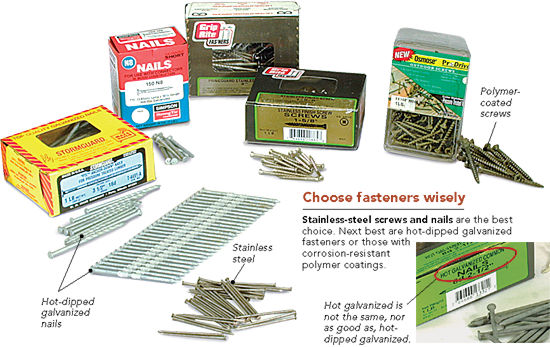
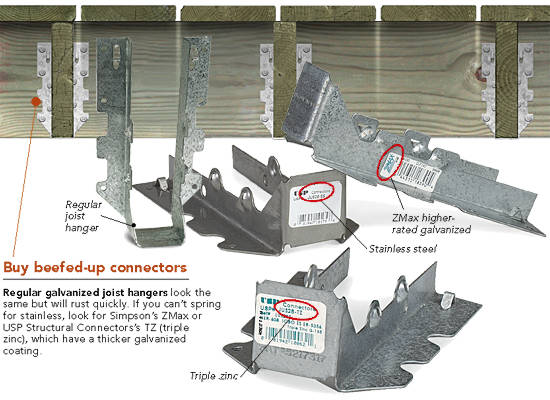
You are the weakest link
The weak links in the system with the new treatments are instances where there’s a significant chance of using the wrong fastener or flashing. Deck flashings will have to be either galvanized or copper.
Pressure-treated bottom plates in slab-on-grade construction also offer weak links. Cumulative effects of corrosion could be catastrophic in tornado and hurricane zones. Will production-framing crews meticulously switch to galvanized nails when nailing studs and sheathing to the bottom plate? And what about foundation anchor bolts, which attach pressure-treated mudsills to basement walls? Galvanized versions are made, but they aren’t commonly available.
Nails for powder-actuated tools and retrofit expansion bolts have a zinc plating, but their electrogalvanizing may need to be boosted to a higher class rating. Engineers at Ramset-Redhead say it’s too early for their corrosion-test results to show a trend.
The wood still needs to dry before you can stain it
Most water repellents can be applied immediately to the new pressure-treated wood, and some manufacturers offer a water-repellent treatment as an upgrade. But manufacturers still recommend an additional level of protection. The wood preservers group suggests waiting for the lumber to dry before applying an oil-based semitransparent stain to the new varieties of pressure-treated lumber. How long you should wait before applying the stain varies depending on where you live. In New Mexico, you probably should wait for six weeks; in New Orleans, six months would be a more preferable length of time.
Borates may be better
Not all pressure-treated lumber is copper-based. Borate-based treatments are also effective at stopping bugs, mold, and rot. Borate lumber treatments have low toxicity levels for people and pets. Borate taken into the body doesn’t build up like heavy metals do; our bodies excrete what they don’t need.
Borate pressure-treated wood has excellent to outstanding corrosion resistance to common metals, according to standards established by the AWPA. No special fasteners or flashings are required.
Lumber treated with disodium octaborate tetrahydrate (DOT) historically has been used in protected, not exposed, locations because borate leaches from wood when the wood gets wet.
But studies show that borate-treated lumber doesn’t leach as much as its reputation suggests.
And borate treatments are getting better. Wood Treatment Products Inc. (www.eswoodtreatment.com) has developed a way to fix borate into lumber better. EnviroSafe Plus is the brand name of this turbo-borate, and it has tested well for borate retention, noncorrosiveness, fire suppression, and nontoxicity of smoke.
Daniel S. Morrison is an assistant editor at Fine Homebuilding. Photos by the author.
Photos: Daniel S. Morrison; drawings: Toby Welles/WowHouse


